North Carolina is no stranger to snow, but now and then, Mother Nature brings a snowstorm that breaks all the records. And that’s exactly what happened from March 12th to 15th of the year 1993, when the biggest March snowstorm hit the state in its history.
From the mountains to the coast, North Carolinians woke up to a winter wonderland that seemed almost surreal. But while the snow might have looked pretty, it caused chaos on the roads and disrupted daily life in many ways.
In this article, we’ll take a closer look at this historic snowstorm and its impact on the people of North Carolina. So grab a cup of hot cocoa, sit back, and get ready to relive the memories of one of the most unforgettable weather events in recent state history.
What is the Typical Weather for the State of North Carolina During March?

North Carolina tends to have pleasant March weather in the western region.
©iStock.com/albertc111
March in North Carolina is a bit of a mixed bag regarding the weather. It’s a time when things are starting to warm up after winter, but it’s not quite spring yet. Depending on where you are in the state, you might experience different weather patterns.
If you’re in the western part of the state, March tends to be pretty dry with pleasant temperatures. You might still see some snow on the ground, but it’s usually starting to melt away. In the eastern part of the state, things can be a bit rainier, with some occasional thunderstorms. Temperatures there are typically a bit warmer than in the west, but you’ll still want to pack some warm clothes for the mornings and evenings.
Overall, the March weather in North Carolina is usually pretty nice, with mild temperatures and sunny skies. But it’s always a good idea to check the forecast and bring some layers if the weather is unpredictable.
What was the Biggest Snowstorm to Ever Hit North Carolina During March?

The worst snowstorm in March for North Carolina blanked the state in beautiful white snow.
©Charles Collard/Shutterstock.com
The snowstorm that hit North Carolina in 1993 on March 12th was one of the most powerful storms ever to hit the state. The heavy snowfall blanketed the entire state under a thick layer of white powder, and the high winds accompanying it caused even more damage across North Carolina.
Up to two feet of snow fell in Durham County, bringing many everyday activities to a complete standstill. Trees were uprooted, power lines were knocked down, and roads were blocked by fallen debris, making travel difficult for some days following the storm, if not impossible. The initial round of snow left behind dangerous icy conditions that made driving hazardous and caused numerous accidents as people tried to return to their everyday routines after being indoors all day.
This snowstorm was much stronger than the ones typically seen in North Carolina during March. Usually, temperatures range between 50-70 degrees Fahrenheit, but this particular year saw a powerful cold front descend upon the state and unprecedented precipitation. Some areas experienced more than double their average monthly snowfall within just a few hours. This led to massive flooding in low-lying areas and even dangerous ice accumulations on roads and sidewalks due to extreme cold temperatures causing snow and ice to remain on the ground longer than usual.
How Did the Snowstorm Affect Residents Living in the State?

The biggest March snowstorm in North Carolina brought hundreds of flight cancellations.
©B Calkins/Shutterstock.com
People across North Carolina were affected by this powerful winter weather event; it disrupted transportation, causing delays and cancellations in both public transport and private vehicles. It also caused flooding in low-lying areas due to increased precipitation, as many areas experienced more than double their monthly average within just a few hours.
This extreme weather is a reminder of how mighty Mother Nature can be and serves as a warning of potential impacts from climate change; increased extremes may become increasingly common due to our warming planet, putting people at risk from floods, droughts, and other natural disasters. Here’s an in-depth look at how the storm affected North Carolina residents:
Poor Transportation Networks
The 1993 snowstorm caused significant disruptions to transportation networks in North Carolina. The heavy snowfall and strong winds made it difficult for locals to travel by private vehicles, with roads blocked by fallen debris and treacherous icy conditions. Public transportation was equally affected, with buses and trains experiencing delays and cancellations due to the conditions. Many people found it impossible to travel, as roads were too icy or blocked off.
In Durham County, up to two feet of snow fell, which caused further disruption, with trees uprooted and power lines knocked down. This created additional dangers for those trying to travel, with downed power lines presenting a lethal hazard that could not be ignored. Furthermore, the cold temperatures kept the snow and ice on the ground for longer than usual, making it even more difficult for people to move around safely.
Canceled Flights
Many flights were canceled or significantly delayed due to the dangerous conditions on the ground. While airports remained open, the icy roads made it difficult for passengers to reach them, resulting in missed flights and frustrated travelers. The strong winds also caused flight turbulence, leading to further delays and many people stuck in airports waiting for their next available flight.
The storm crippled airports as well, with some experiencing power outages due to downed power lines or heavy snowfall, which blocked access roads and runways. This caused a ripple effect of cancellations that spread far beyond North Carolina as some airlines struggled to reroute affected passengers from other states.
Frequent Power Outages
The snowstorm caused power outages across the state, leaving many residents without electricity for several hours or even days. This made it difficult to stay warm and affected communication and the ability to access essential services.
Mental Health
In addition to the practical difficulties caused by the snowstorm, it also impacted residents emotionally. Many people were stuck inside their homes for long periods, unable to go outside or socialize with others. This led to feelings of isolation and loneliness, which can significantly impact mental health.
Agriculture
The snowstorm had a damaging effect on agriculture in North Carolina. Farmers struggled to protect their crops from the cold and wet conditions brought by the blizzard, leading to lower yields and lost harvests in many parts of the state. Livestock farmers were also affected as temperatures dropped too low for animals to handle, leading to losses in distinct herds.
The storm’s effects adversely impacted many businesses that relied on farming as part of their operations on crops and livestock. As a result, some agriculture-related jobs were lost during this time, while other businesses suffered financial hardship due to decreased demand associated with crop losses.
Despite the challenges brought on by the snowstorm, North Carolina residents demonstrated resilience and community spirit. Neighbors helped each other shovel driveways and clear sidewalks while emergency services worked around the clock to keep people safe and provide essential support.
How Do Late-Season Snowstorms Impact Wildlife in North Carolina?
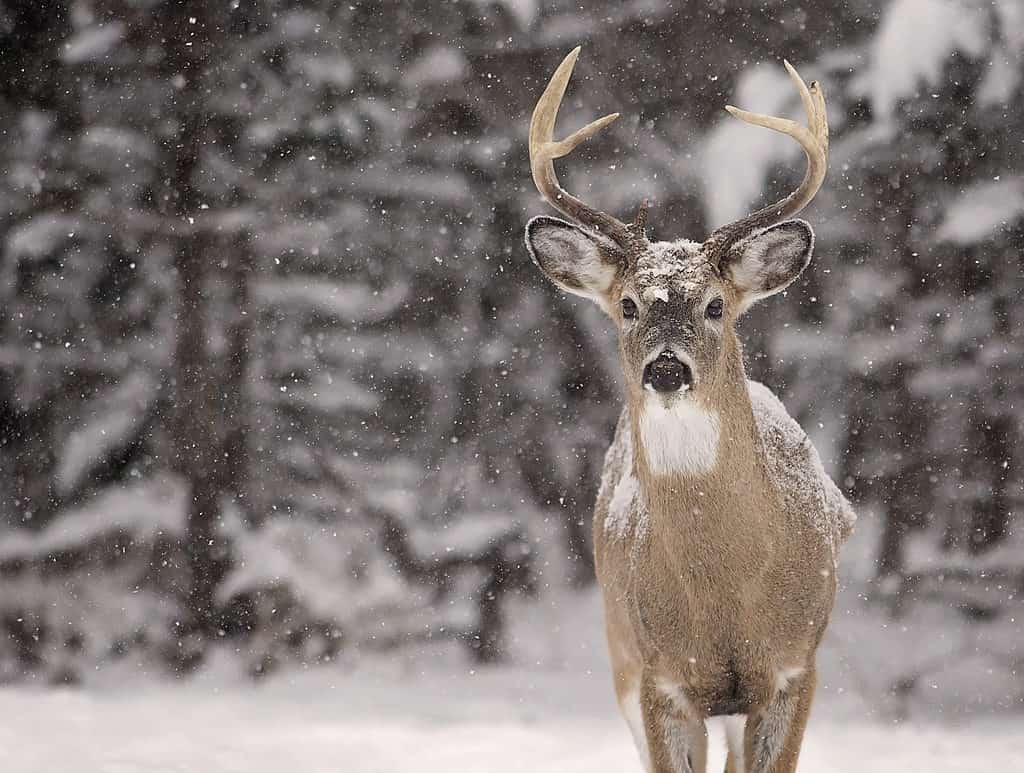
White-tailed deer and other animals may have had difficulty finding food in the biggest March snowstorm recorded in North Carolina.
©iStock.com/Lynn_Bystrom
The heavy snowfall and strong winds created a challenging environment for many animals, making it harder for them to find food and shelter. This can be particularly damaging during late-season snowstorms since animals already have a shortage of resources due to the winter months; extended periods of cold weather make it even more difficult for them to survive.
In addition, the snow and ice on the ground can limit an animal’s mobility and make it harder for them to find food or escape predators. Although some animals, such as deer, can use their hooves to dig through the snow and ice, others, such as rabbits or squirrels, may struggle due to their smaller size and lack of specialized equipment. Cold temperatures can also cause frostbite in some species, resulting in further discomfort and potential threats from predators.
For humans, late-season snowstorms can impact wildlife populations in several ways. When roads become blocked by fallen debris or icy conditions, people may take alternative routes that cut through habitats home to many species. These disturbed habitats may not provide enough protection from predators or enough food sources for animals trying to survive the winter months; this could lead to a decrease in population numbers, which we should all strive to avoid.
How Do Animals in North Carolina Cope amid a Snowstorm?
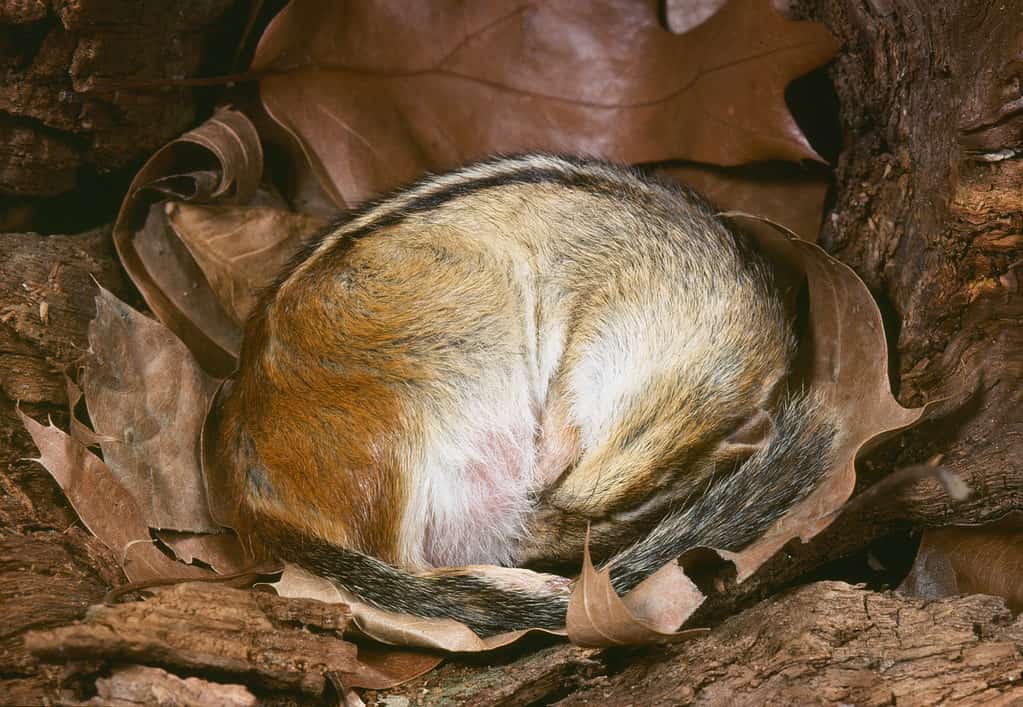
Chipmunks find shelter in logs and homes during extreme winter.
©Breck P. Kent/Shutterstock.com
No matter the season, North Carolina’s wildlife must be able to adapt to survive. This can be especially difficult during unexpected late-season snowstorms when animals may not have had time to prepare for the harsh conditions. But how exactly do these creatures cope with such extreme weather? Let’s look at some of North Carolina wildlife’s strategies to make it through a snowstorm.
Chipmunks

Chipmunks get creative to find food.
©colacat/Shutterstock.com
Faced with extreme conditions threatening their well-being, chipmunks had to get creative to stay warm and find food. To keep warm, they found shelter in logs or under leaves – often inside people’s homes. To keep their hunger at bay, they ate whatever they could find, such as nuts, berries, seeds, or bread crumbs, that people were kind enough to provide. Unfortunately, some chipmunks didn’t survive the storm due to a lack of food and extreme cold temperatures.
Beavers
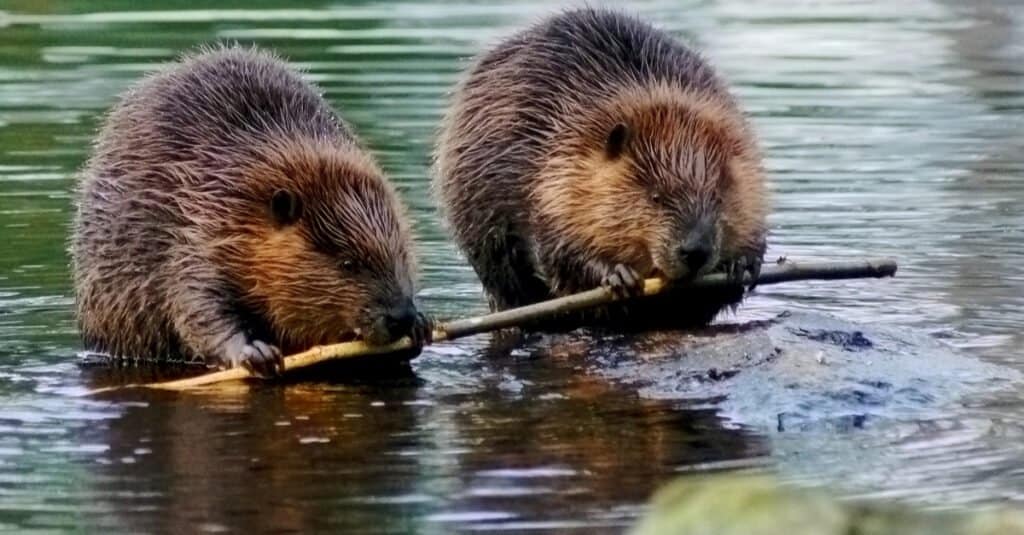
Beavers are very resourceful in the winter.
©P Harstela/Shutterstock.com
Beavers are well adapted to cope with winter conditions, including snowstorms. These industrious animals are known for their dam-building skills, which create ponds and wetlands that provide them with food, shelter, and protection during the winter.
Beavers will typically retreat to their lodges or burrows, constructed to keep them warm and dry. Beavers also have a thick layer of fur, which insulates them against the cold and keeps them warm.
The snowstorm will make it rather difficult for beavers to find food. This is because their primary source of food is the bark of trees. Beavers have adapted by storing branches and other food sources in the water near their lodges, where they can easily access them even if the ground is covered in snow.
Armadillos

Armadillos are relatively fast.
©mariamalaya/Shutterstock.com
Armadillos are not native to areas that experience snowstorms, but in the rare instances when they do occur, these animals must find ways to cope with the sudden change in their environment.
To stay warm during a snowstorm, armadillos may seek out areas sheltered from the snow and wind, such as burrows or other underground spaces. However, their primary adaptation for staying warm is their tough, armored shell, which provides a layer of insulation to keep them from losing too much body heat.
During a snowstorm, finding food can be challenging for armadillos, as they usually forage insects and other small creatures on the ground. With snow covering their food sources, armadillos may have to dig through the snow to find food or switch to eating plants or other available food sources.
White-Tailed Deer
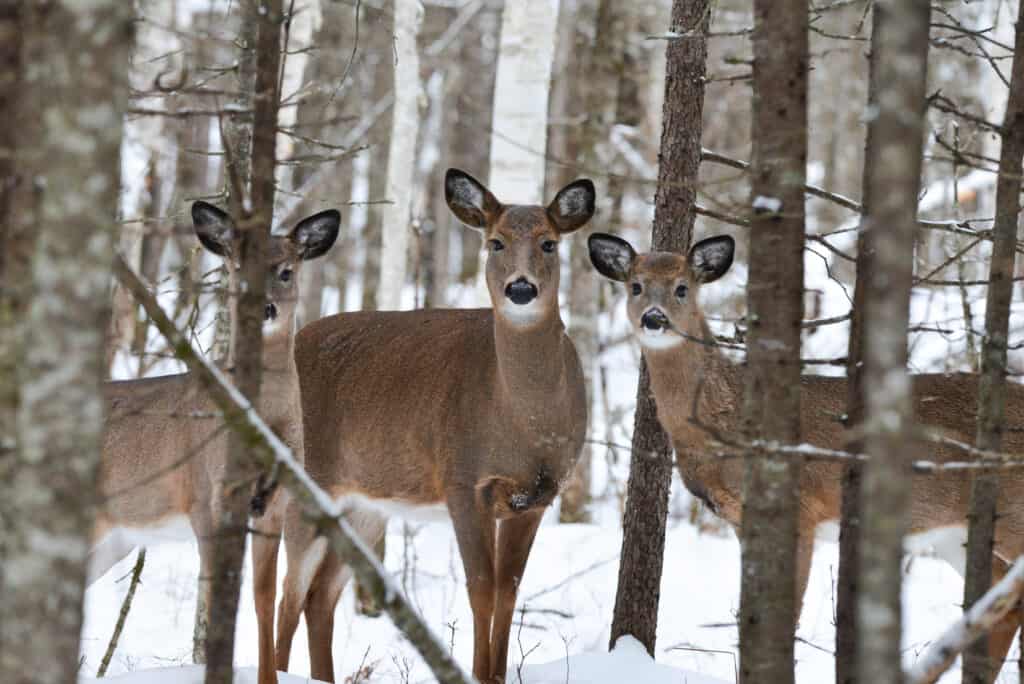
Deer use thickets and other covered areas to stay warm during winters.
©Rebecca C. Photography/Shutterstock.com
When a snowstorm arrives, white-tailed deer must rely on their instincts to deal with the harsh winter conditions. These big herbivores must find ways to stay warm, sheltered, and fed.
To stay warm, deer seek out protected areas like thickets, brush piles, and other areas that offer cover from the snow and wind. This keeps them from using too much energy and helps them stay warm.
Finding food can be challenging when the ground is covered in snow. Deer usually eat plants and grasses, but they have to dig through the snow to find anything. They may start nibbling on bark, twigs, and other woody material available during winter to cope.
Birds
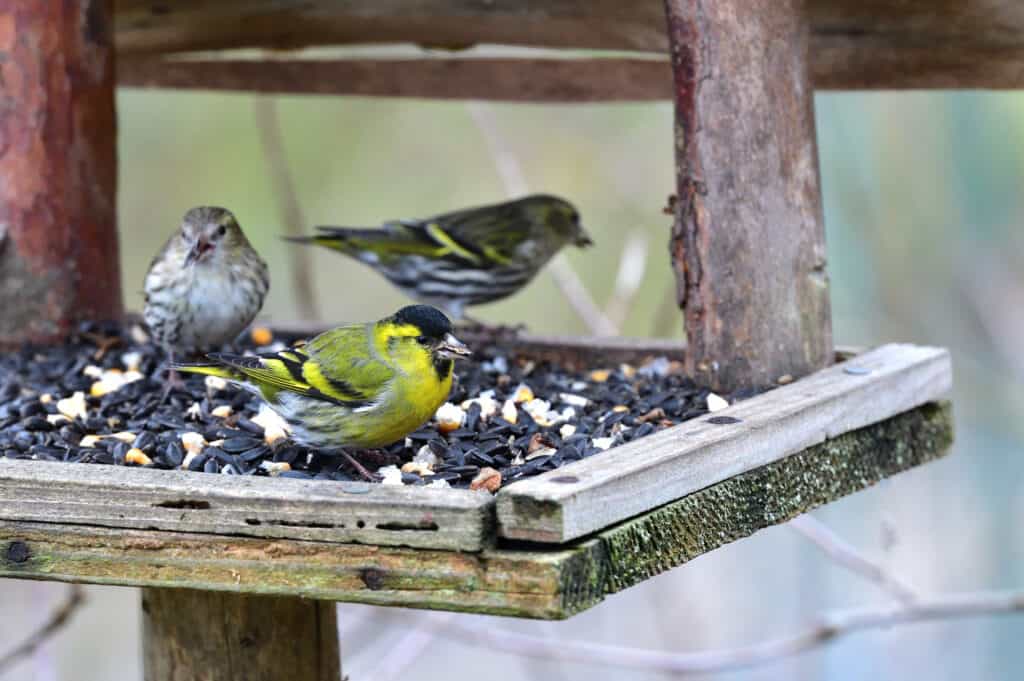
Birds appreciate a bird feeder during the winter.
©Klimek Pavol/Shutterstock.com
Finding food can be tricky during a snowstorm, so birds change their feeding patterns to survive. Instead of hunting for insects or worms on the ground, they’ll search for berries, seeds, and other food that’s easier to find in snowy conditions. In some cases, birds will visit bird feeders that humans set out to get the necessary sustenance.
To stay warm, birds fluff up their feathers, which acts like a natural insulation layer to keep them cozy. They also lower their body temperature at night to save energy. Chickadees and nuthatches are known for this unique adaptation that helps them endure harsh winters.
Fish
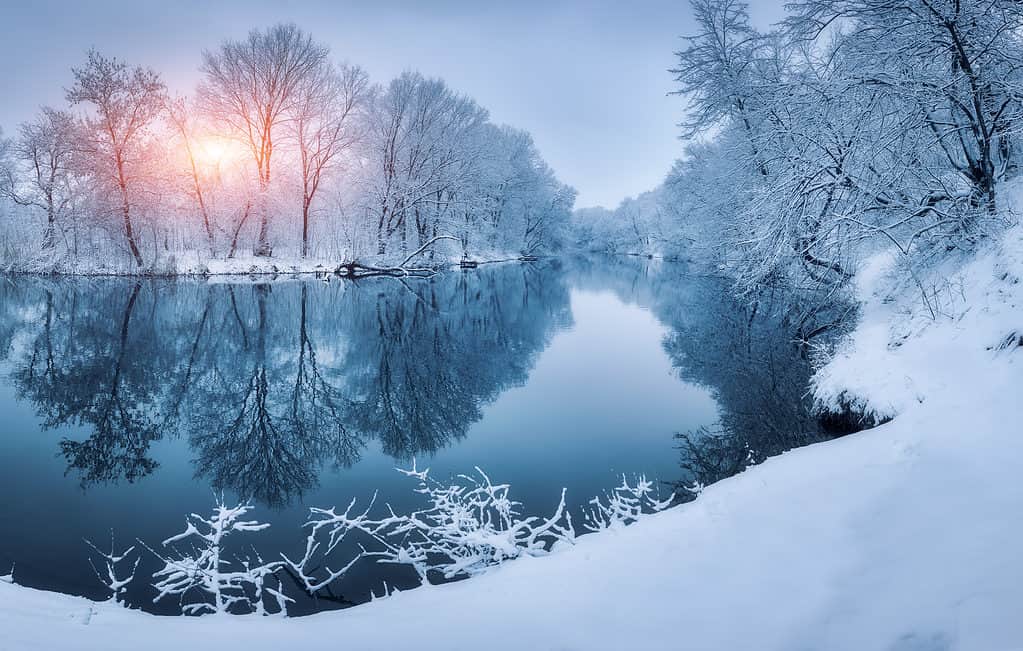
Winter sends most fish down to the depths.
©iStock.com/den-belitsky
During a snowstorm, the air temperature can drop rapidly, causing the water temperature to also decrease. This sudden temperature change can be stressful for fish, especially those not adapted to cold water. In addition, snow melting and running off into bodies of water can cause the water level to rise and the water quality to change, potentially affecting the survival of aquatic organisms.
Some fish species have adapted to cold water and can survive in low temperatures, while others migrate to warmer waters during the winter. Trout, for example, are a cold-water species that can tolerate low temperatures, while salmon migrate from the ocean to freshwater streams to spawn during the winter.
Bottom Line
The most significant snowstorm to ever hit North Carolina occurred in March 1993, leaving a lasting impression on the state’s residents and wildlife. It was an incredible event that tested the limits of human resilience and animal adaptability. Despite its hardships, this historic storm also revealed how people and animals could survive unexpected challenges. Many citizens had to find creative solutions quickly to stay warm and fed.
On the other hand, animals had their strategies for enduring harsh weather conditions; they adapted rapidly by becoming more active at night or relying on stores of food they had previously gathered. The powerful snowstorm should be remembered as a time when we overcame adversity with strength and hope. We can take courage from those who endured the blizzard and use their example as a reminder that anything is possible with dedication and flexibility.
The photo featured at the top of this post is © Charles Collard/Shutterstock.com
Thank you for reading! Have some feedback for us? Contact the AZ Animals editorial team.






